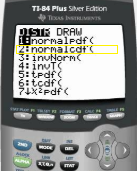TI 83 > TI 83 NormalCDF
TI 83 NormalCDF / TI 84: Overview
The TI 83 and TI 84 graphing calculators can help you figure out normal distribution probabilities with the normalcdf function.
Normalcdf is the normal (Gaussian) cumulative distribution function on the TI 83/TI 84 calculator. If a random variable is normally distributed, you can use the normalcdf command to find the probability that the variable will fall into a certain interval that you supply.
Where is NormalCDF on the Calculator?
On both the TI 84 and TI 83, NormCDF is in the same place:
- Press the 2nd key.
- Press VARS .
- Scroll to option 2 (or just press “2”) for “normalcdf.”
Format
The format for normalcdf is: normalcdf(lower bound, upper bound, mean, standard deviation). If you have a standard normal distribution (where the mean is 0 and the standard deviation is 1) you can leave the last two variables out, as those are the default settings on the calculator.
TI 83 NormalCDF & TI 84: Steps
Watch the video for the steps. Although I’m using a TI 83 here, the TI 84 steps are identical:
Example problem: A group of students taking end of semester statistics exams at a certain college have a mean score of 75 and a standard deviation of 5 points. What is the probability that a given student will score between 90 and 100 points? Use the NormalCDF function.
Step 1: Press the 2nd key and then press VARS then 2 to get “normalcdf.”
Step 2: Enter the following numbers into the screen:
90 for the lower bound, followed by a comma, then 100 for the upper bound, followed by another comma.
Step 3: Press 75 (for the mean), followed by a comma and then 5 (for the standard deviation).
Step 4: Close the argument list with a “)”. (Your display should now read normalcdf(90, 100, 75, 5).) Now press ENTER. The calculator returns the probability, which in this case is 0.00135, or .135% (to three decimal places).
That’s how to use the TI 83 NormalCDF function!
Lost your guidebook? Download a new one here from the TI website.
Check out our Youtube channel for more stats help and tips!
References
Deviant, S. The Practically Cheating Statistics Handbook TI-83 Companion Guide.
